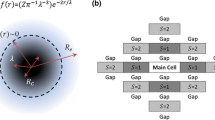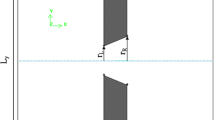Abstract
One of the difficulties in molecular simulation of pressure-driven fluid flow in nanochannels is to find an appropriate pressure control method. When periodic boundary conditions (PBCs) are applied, a gravity-like field has been widely used to replace actual pressure gradients. The gravity-fed method is not only artificial, but not adequate for studying properties of fluid systems which are essentially inhomogeneous in the flow direction. In this paper, a method is proposed which can generate any desired pressure difference to drive the fluid flow by attaching a “pump” to the nanofluidic system, while the model is still compatible with PBCs. The molecular dynamics model based on the proposed method is applied to incompressible flows in smooth nanochannels, and the predicted velocity profiles are identical to those by the gravity-fed method, as expected. For compressible flows, the proposed model successfully predicts the changes of fluid density and velocity profile in the flow direction, while the gravity-fed method can only predict constant fluid properties. For fluid flows in nanochannels with a variable cross-sectional area, the proposed model predicts higher mass flow rates as compared to the gravity-fed method and possible reasons for the difference are discussed.








Similar content being viewed by others
References
Ajayan PM, Stephan O, Redlich Ph, Colliex C (1995) Carbon nanotubes as removable templates for metal oxide nanocomposites and nanostructures. Nature (London) 375:564–567
Alexiadis A, Kassinos S (2008) Molecular simulation of water in carbon nanotubes. Chem Rev 108:5014–5034
Andersen HC (1980) Molecular dynamics simulations at constant pressure and/or temperature. J Chem Phys 72:2384–2393
Auletta T, Dordi B, Mulder A, Sartori A, Onclin S, Bruinink CM, Peter M, Nijhuis A, Beijleveld H, Schonherr H, Vancso GJ, Casnati A, Ungaro R, Ravoo BJ, Huskens J, Reinhoudt DN (2004) Writing patterns of molecules on molecular printboards. Angew Chem Int Ed 43:369–373
Barrat JL, Bocquet L (1999) Large slip effect at a nonwetting fluid–solid interface. Phys Rev Lett 82:4671–4674
Berendsen HJC, Postma JPM, van Gunsteren WF, Di Nola A, Haak JR (1984) Molecular dynamics with coupling to an external bath. J Chem Phys 81:3684–3690
Bernardi S, Todd BD, Searles DJ (2010) Thermostating highly confined fluids. J Chem Phys 132:244706
Cieplak M, Koplik J, Banavar JR (2006) Nanoscale fluid flows in the vicinity of patterned surfaces. Phys Rev Lett 96:114502
Frenkel D, Smit B (2002) Understanding molecular simulation from algorithms to applications. Academic press, San Diego
Hanasaki I, Nakatani A (2006) Fluidized piston model for molecular dynamics simulations of hydrodynamic flow. Model Simul Mater Sci Eng 14:S9–S20
Heffelfinger GS, van Swol F (1994) Diffusion in Lennard–Jones fluids using dual control volume grand canonical molecular dynamics simulation (DCV–GCMD). J Chem Phys 100:7548–7552
Holt JK, Park HG, Wang YM, Stadermann M, Artyukhin AB, Grigoropoulos CP, Noy A, Bakajin O (2006) Fast mass transport through sub—2-nanometer carbon nanotubes. Science 312:1034–1037
Huang C, Choi PYK, Nandakumar K, Kostiuk LW (2007) Comparative study between continuum and atomistic approaches of liquid flow through a finite length cylindrical nanopore. J Chem Phys 126:224702
Kannam SK, Todd BD, Hansen JS, Daivis P (2011) Slip flow in graphene nanochannels. J Chem Phys 135:144701
Kuang C, Wang G (2010) A novel far–field nanoscopic velocimetry for nanofluidics. Lab Chip 10:240–245
Li Y, Xu J, Li D (2010) Molecular dynamics simulation of nanoscale liquid flows. Microfluid Nanofluid 9:1011–1031
Liang Z, Tsai HL (2010) Prediction of transport properties of a polyatomic gas. Fluid Phase Equilib 293:196–204
Liang Z, Tsai HL (2011) Effects of molecular film thickness on thermal conduction across solid-film interfaces. Phys Rev E 83:061603
Lincoln RC, Koliwad KM, Ghate PB (1967) Morse-potential evaluation of second- and third-order elastic constants of some cubic metals. Phys Rev 157:463–466
Linstrom PJ, Mallard WG (2011) National Institute of Standards and Technology, Gaithersburg MD, 20899. http://webbook.nist.gov
Liu C, Li ZG (2009) Flow regimes and parameter dependence in nanochannel flows. Phys Rev E 80:036302
Liu C, Fan Y, Cong HT, Cheng HM, Dreselhaus MS (1999) Hydrogen storage in single-walled carbon nanotubes at room temperature. Science 286:1127–1129
Maitland GC, Rigby M, Smith EB, Wakeham WA (1981) Intermolecular forces: their origin and determination. Clarendon Press, Oxford
Nagayama G, Cheng P (2004) Effects of interface wettability on microscale flow by molecular dynamics simulation. Int J Heat Mass Transf 47:501–513
Schlichting H (1979) Boundary layer theory, 7th edn. McGraw-Hill, New York
Takaba H, Onumata Y, Nakao S (2007) Molecular simulation of pressure-driven fluid flow in nanoporous membranes. J Chem Phys 127:054703
Todd BD, Evans DJ, Daivis PJ (1995) Pressure tensor for inhomogeneous fluids. Phys Rev E 52:1627–1638
Unguris J, Bruch LW, Moog ER, Webb MB (1981) Ar and Kr adsorption on Ag(111). Surf Sci 109:522–556
van der Heyden FHJ, Stein D, Dekker C (2005) Streaming current in a single nanofluidic channel. Phys Rev Lett 95:116104
van der Heyden FHJ, Bonthuis DJ, Stein D, Meyer C, Dekker C (2007) Power generation by pressure-driven transport of ions in nanofluidic channels. Nano Lett 7:1022–1025
Wang Q, Challa SR, Sholl DS, Jonhson JK (1999) Quantum sieving in carbon nanotubes and zerolites. Phys Rev Lett 82:956–959
Yang SC (2006) Effects of surface roughness and interface wettability on nanoscale flow in a nanochannel. Microfluid Nanofluid 2:501–511
Zheng M, Jagota A, Semke ED, Diner BA, Mclean RS, Lustig SR, Richardson RE, Tassi NG (2003) DNA-assisted dispersion and separation of carbon nanotubes. Nat Mater 2:338–342
Zhu Y, Granick S (2002) Limits of the hydrodynamic no-slip boundary condition. Phys Rev Lett 88:106102
Acknowledgments
We thank National Institute for Computational Science (NICS) and National Center for Supercomputing Applications (NCSA) for providing us supercomputer resources for MD simulations.
Author information
Authors and Affiliations
Corresponding author
Rights and permissions
About this article
Cite this article
Liang, Z., Tsai, HL. A method to generate pressure gradients for molecular simulation of pressure-driven flows in nanochannels. Microfluid Nanofluid 13, 289–298 (2012). https://doi.org/10.1007/s10404-012-0960-4
Received:
Accepted:
Published:
Issue Date:
DOI: https://doi.org/10.1007/s10404-012-0960-4




